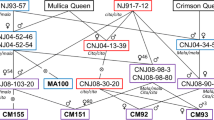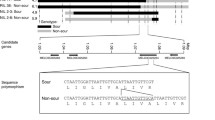Abstract
Sweet melon cultivars contain a low level of organic acids and, therefore, the quality and flavor of sweet melon fruit is determined almost exclusively by fruit sugar content. However, genetic variability for fruit acid levels in the Cucumis melo species exists and sour fruit accessions are characterized by acidic fruit pH of <5, compared to the sweet cultivars that are generally characterized by mature fruit pH values of >6. In this paper, we report results from a mapping population based on recombinant inbred lines (RILs) derived from the cross between the non-sour ‘Dulce’ variety and the sour PI 414323 accession. Results show that a single major QTL for pH co-localizes with major QTLs for the two predominant organic acids in melon fruit, citric and malic, together with an additional metabolite which we identified as uridine. While the acidic recombinants were characterized by higher citric and malic acid levels, the non-acidic recombinants had a higher uridine content than did the acidic recombinants. Additional minor QTLs for pH, citric acid and malic acid were also identified and for these the increased acidity was unexpectedly contributed by the non-sour parent. To test for co-localization of these QTLs with genes encoding organic acid metabolism and transport, we mapped the genes encoding structural enzymes and proteins involved in organic acid metabolism, transport and vacuolar H+ pumps. None of these genes co-localized with the major pH QTL, indicating that the gene determining melon fruit pH is not one of the candidate genes encoding this primary metabolic pathway. Linked markers were tested in two additional inter-varietal populations and shown to be linked to the pH trait. The presence of the same QTL in such diverse segregating populations suggests that the trait is determined throughout the species by variability in the same gene and is indicative of a major role of the evolution of this gene in determining the important domestication trait of fruit acidity within the species.



Similar content being viewed by others
References
Baxter CJ, Sabar M, Quick WP, Sweetlove LJ (2005) Comparison of changes in fruit gene expression in tomato introgression lines provides evidence of genome-wide transcriptional changes and reveals links to mapped QTLs and described traits. J Exp Bot 56:1591–1604
Bermudez L, Urias U, Milstein D, Kamenetzky L, Asis R, Fernie AR, Van Sluys MA, Carrari F, Rossi M (2008) A candidate gene survey of quantitative trait loci affecting chemical composition in tomato fruit. J Exp Bot 59:2875–2890
Brune A, Muller M, Taiz L, Gonzalez PC, Etxeberria E (2002) Vacuolar acidification in citrus fruit: comparison between acid lime (Citrus aurantifolia) and sweet lime (Citrus limettioides) juice cells. J Am Soc Hortic Sci 127:171–177
Burger Y, Sa’ar U, Distelfeld A, Katzir N, Yeselson Y, Shen S, Schaffer AA (2003) Development of sweet melon (Cucumis melo) genotypes combining high sucrose and organic acid content. J Am Soc Hortic Sci 128:537–540
Burger Y, Paris H, Cohen R, Katzir N, Tadmor Y, Lewinsohn E, Schaffer AA (2009) Genetic diversity of Cucumis melo. Hortic Rev 36:165–198
Cao XW, Li J, Chen SB, Li XB, Xiao PG, Chen SL, Yang DJ (2010) Simultaneous determination of nine nucleosides and nucleobases in different Fritillaria species by HPLC-diode array detector. J Sep Sci 33:1587–1594
Causse M, Duffe P, Gomez MC, Buret M, Damidaux R, Zamir D, Gur A, Chevalier C, Lemaire-Chamley M, Rothan C (2004) A genetic map of candidate genes and QTLs involved in tomato fruit size and composition. J Exp Bot 403:1671–1685
Clepet C, Joobeur T, Zheng Y, Jublot D, Huang M, Truniger V, Boualem A, Hernandez-Gonzalez ME, Dolcet -Sanjuan R, Portnoy V, Creus AM, Caño-Delgado A, Katzir N, Giovannoni JJ, Bendahmane A, Aranda MA, Garcia-Mas J, Fei Z (2011) Analysis of expressed sequence tags generated from full-length enriched cDNA libraries of melon. BMC Genomics 12:252. doi:10.1186/1471-2164-12-252
Cuevas HE, Staub JE, Simon PW, Zalapa JE, McCreight JD (2008) Mapping of genetic loci that regulate quantity of beta-carotene in fruit of US Western Shipping melon (Cucumis melo L.). Theor Appl Genet 117:1345–1359
Cuevas HE, Staub JE, Simon PW, Zalapa JE (2009) A consensus linkage map identifies genomic regions controlling fruit maturity and beta-carotene-associated flesh color in melon (Cucumis melo L.). Theor Appl Genet 119:741–756
Danin-Poleg Y, Tadmor Y, Tzuri G, Reis N, Hirschberg J, Katzir N (2002) Construction of a genetic map of melon with molecular markers and horticultural traits, and localization of genes associated with ZYMV resistance. Euphytica 125:373–384
De Jong WS, Eannetta NT, De Jong DM, Bodis M (2004) Candidate gene analysis of anthocyanin pigmentation loci in the Solanaceae. Theor Appl Genet 108:423–432
Diaz A, Fergany M, Formisano G, Ziarsolo P, Blanca J, Fei Z, Staub JE, Zalapa JE, Cuevas HE, Dace G, Oliver M, Boissot N, Dogimont C, Pitrat M, Hofstede R, van Koert P, Harel-Beja R, Tzuri G, Portnoy V, Cohen S, Schaffer A, Katzir N, Xu Y, Zhang H, Fukino N, Matsumoto S, Garcia-Mas J, Monforte AJ (2011) A consensus linkage map for molecular markers and quantitative trait loci associated with economically important traits in melon (Cucumis melo L.). BMC Plant Biol 11:111
Etienne C, Rothan C, Moing A, Plomion C, Bodenes C, Svanella-Dumas L, Cosson P, Pronier V, Monet R, Dirlewanger E (2002) Candidate genes and QTLs for sugar and organic acid content in peach [Prunus persica (L.) Batsch]. Theor Appl Genet 105:145–159
Fang DQ, Federici CT, Roose ML (1997) Development of molecular markers linked to a gene controlling fruit acidity in citrus. Genome 40:841–849
Fulton TM, Chunwongse J, Tanksley SD (1995) Microprep protocol for extraction of DNA from tomato and other herbaceous plants. Plant Mol Biol Rep 13:207–209
Fulton TM, Bucheli P, Viorol E, Lopez J, Petiard V, Tanksley SD (2002) Quantitative trait loci (QTL) affecting sugars, organic acids and other biochemical properties possibly contributing to flavor, identified in four advanced backcross populations of tomato. Euphytica 127:163–177
Guo S, Duan JA, Tang YP, Zhu ZH, Qian YF, Yang NY, Shang EX, Qian DW (2010) Characterization of nucleosides and nucleobases in fruits of Ziziphus jujuba by UPLC–DAD–MS. J Agric Food Chem 58:10774–10780
Harel-Beja R, Tzuri G, Portnoy V, Lotan-Pompan M, Lev S, Cohen S, Dai N, Yeselson L, Meir A, Libhaber SE, Avisar E, Melame T, van Koert P, Verbakel H, Hofstede R, Volpin H, Oliver M, Fougedoire A, Stalh C, Fauve J, Copes B, Fei Z, Giovannoni J, Ori N, Lewinsohn E, Sherman A, Burger Y, Tadmor Y, Schaffer AA, Katzir N (2010) A genetic map of melon highly enriched with fruit quality QTLs and EST markers, including sugar and carotenoid metabolism genes. Theor Appl Genet 121:511–533
Itkin M, Rogachev I, Alkan N, Rosenberg T, Malitsky S, Masini L, Meir S, Iijima Y, Aoki K, de Vos R, Prusky D, Burdman S, Beekwilder J, Aharoni A (2011) GLYCOALKALOID METABOLISM 1 is required for steroidal alkaloid glycosylation and prevention of phytotoxicity in tomato. Plant Cell. doi:10.1105/tpc.111.088732
Kellner S, Seidu-Larry S, Burhenne J, Motorin Y, Helm M (2011) A multifunctional bioconjugate module for versatile photoaffinity labeling and click chemistry of RNA. Nucl Acids Res. doi:10.1093/nar/gkr449
Kubicki B (1962) Inheritance of some characters in muskmelons (Cucumis melo). Genet Polonica 3:265–274
Leach DN, Sarafis V, Spooner-Hart R, Wyllie SG (1989) Chemical and biological parameters of some cultivars of C. melo. Acta Hortic 247:353–356
Linden K (2004) Disinfection efficiency and dose measurement of polychromatic UV light (Paperback). IWA Publishing, UK
Liu Y-S, Gur A, Ronen G, Causse M, Damidaux R, Buret M, Hirschberg J, Zamir D (2003) There is more to tomato fruit colour than candidate carotenoid genes. Plant Biotechnol J 1:195–207
Luo M, Wang YH, Frisch D, Joobeur T, Wing RA, Dean RA (2001) Melon bacterial artificial chromosome (BAC) library construction using improved methods and identification of clones linked to the locus conferring resistance to melon Fusarium wilt (Fom-2). Genome 44:154–162
Marsh K, González P, Echeverría E (2001) Partial characterization of H-translocating inorganic pyrophosphatase from 3 citrus varieties differing in vacuolar pH. Physiol Plant 111:519–526
Moing A, Svanella L, Rolin D, Gaudillere M, Gaudillere JP, Monet R (1998) Compositional changes during the fruit development of two peach cultivars differing in juice acidity. J Am Soc Hortic Sci 123:770–775
Neff MM, Turk E, Kalishman M (2002) Web-based primer design for single nucleotide polymorphism analysis. Trends Genet 2:613–615
Obando-Ulloa JM, Eduardo I, Monforte AJ, Fernandez-Trujillo JP (2009) Identification of QTLs related to sugar and organic acid composition in melon using near-isogenic lines. Sci Hortic 121:425–433
Pitrat M, Hanelt P, Hammer K (2000) Some comments on infraspecific classification of cultivars of melon. Acta Hortic 510:29–36
Portnoy V, Diber A, Pollock S, Forer R, Lev S, Tzuri G, Harel-Beja R, Portnoy VH, Lewinsohn E, Tadmor Y, Burger J, Schaffer AA, Katzir N (2011) Use of non-normalized, non-amplified cDNA for 454-based RNA sequencing of fleshy melon fruit. Plant Genome 4:36–46
Qian ZM, Wan JB, Zhang QW, Li SP (2008) Simultaneous determination of nucleobases, nucleosides and saponins in Panax notoginseng using multiple columns high performance liquid chromatography. J Pharm Biomed Anal 48:1361–1367
Schauer N, Semel Y, Roessner U, Gur A, Balbo I, Carrari F, Pleban T, Perez-Melis A, Bruedigam C, Kopka J, Willmitzer L, Zamir D, Fernie AR (2006) Comprehensive metabolic profiling and phenotyping of interspecific introgression lines for tomato improvement. Nat Biotechnol 24:447–454
Schnarrenberger C, Martin W (2002) Evolution of the enzymes of the citric acid cycle and the glyoxylate cycle of higher plants: a case study of endosymbiotic gene transfer. Eur J Biochem 269:868–883
Stevens MA (1972) Citrate and malate concentrations in tomato fruits: genetic control and maturational effects. J Am Soc Hortic Sci 97:655–658
Stevens R, Buret M, Duffé P, Garchery C, Baldet P, Rothan C, Causse M (2007) Candidate genes and quantitative trait loci affecting fruit ascorbic acid content in three tomato populations. Plant Physiol 143:1943–1953
Ulrich J (1970) Organic acids. In: Hulme AC (ed) The biochemistry of fruits and their products. Academic Press, London, pp 89–117
Van Ooijen JW (2004) MapQTL® 5, software for the mapping of quantitative trait loci in experimental populations. Kyazma B.V, Wageningen
Van Ooijen JW, Voorrips RE (2001) JoinMap® 3.0, software for the calculation of genetic linkage maps. Plant Research International, Wageningen
Wang YM, Wyllie SG, Leach DN (1996) Chemical changes during the development and ripening of the fruit of Cucumis melo (Cv. Makdimon). J Agric Food Chem 44:210–216
Yamaguchi M, Hughes DL, Yabumoto K, Jennings WG (1977) Quality of cantaloupe muskmelons: variability and attributes. Sci Hortic 6:59–64
Acknowledgments
The authors gratefully acknowledge financial support from of the Chief Scientist, Ministry of Agriculture; The Israel Bio-Tov Consortium & MAGNET program, Israeli Ministry of Industry, Trade and Labor; Binational Agriculture Research and Development (BARD) Grant IS-2270-94 and IS-3877-06; Israel Science Foundation Grant No. 386/06. This work was supported by the EU Framework Programme 6 project Meta-Phor (grant no. FOOD-CT-2006-036220). The work in AA lab was supported by the European Research Council (ERC) SAMIT project. This paper is journal series #003-12 of the Agricultural Research Organization.
Author information
Authors and Affiliations
Corresponding author
Additional information
Communicated by H. Nybom.
S. Cohen, G. Tzuri, and R. Harel-Beja contributed equally.
Electronic supplementary material
Below is the link to the electronic supplementary material.
Rights and permissions
About this article
Cite this article
Cohen, S., Tzuri, G., Harel-Beja, R. et al. Co-mapping studies of QTLs for fruit acidity and candidate genes of organic acid metabolism and proton transport in sweet melon (Cucumis melo L.). Theor Appl Genet 125, 343–353 (2012). https://doi.org/10.1007/s00122-012-1837-3
Received:
Accepted:
Published:
Issue Date:
DOI: https://doi.org/10.1007/s00122-012-1837-3




